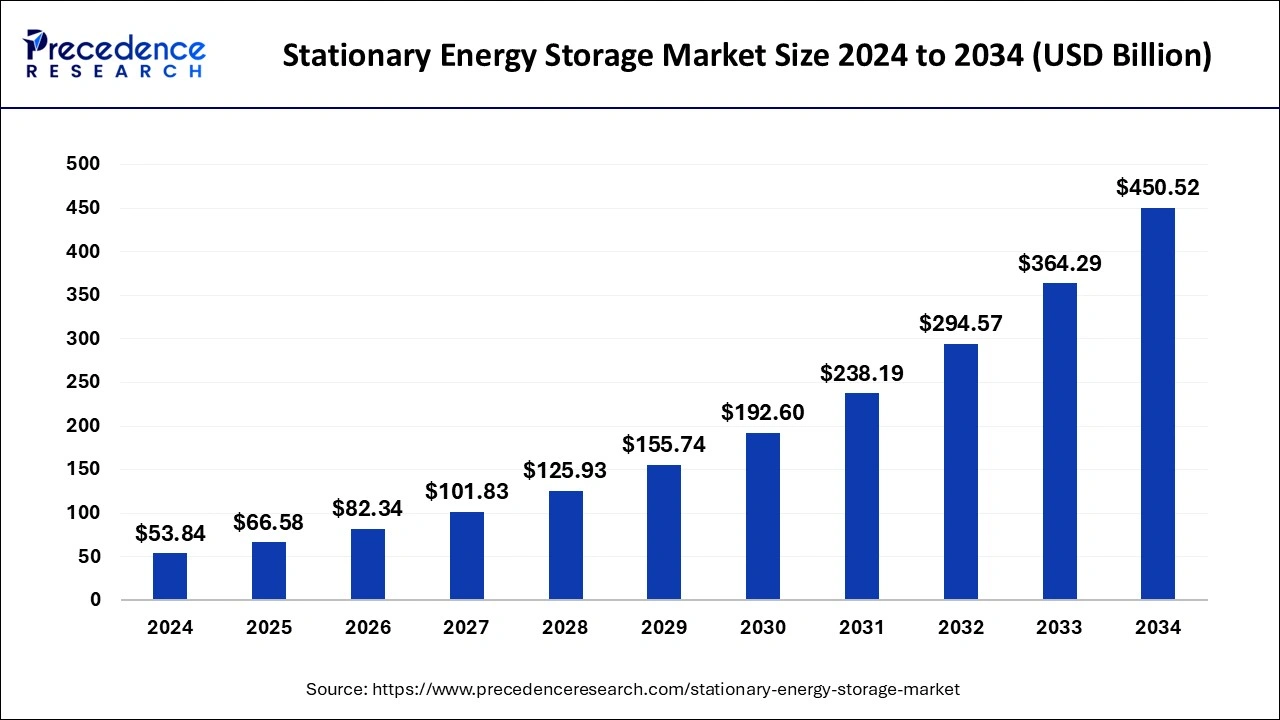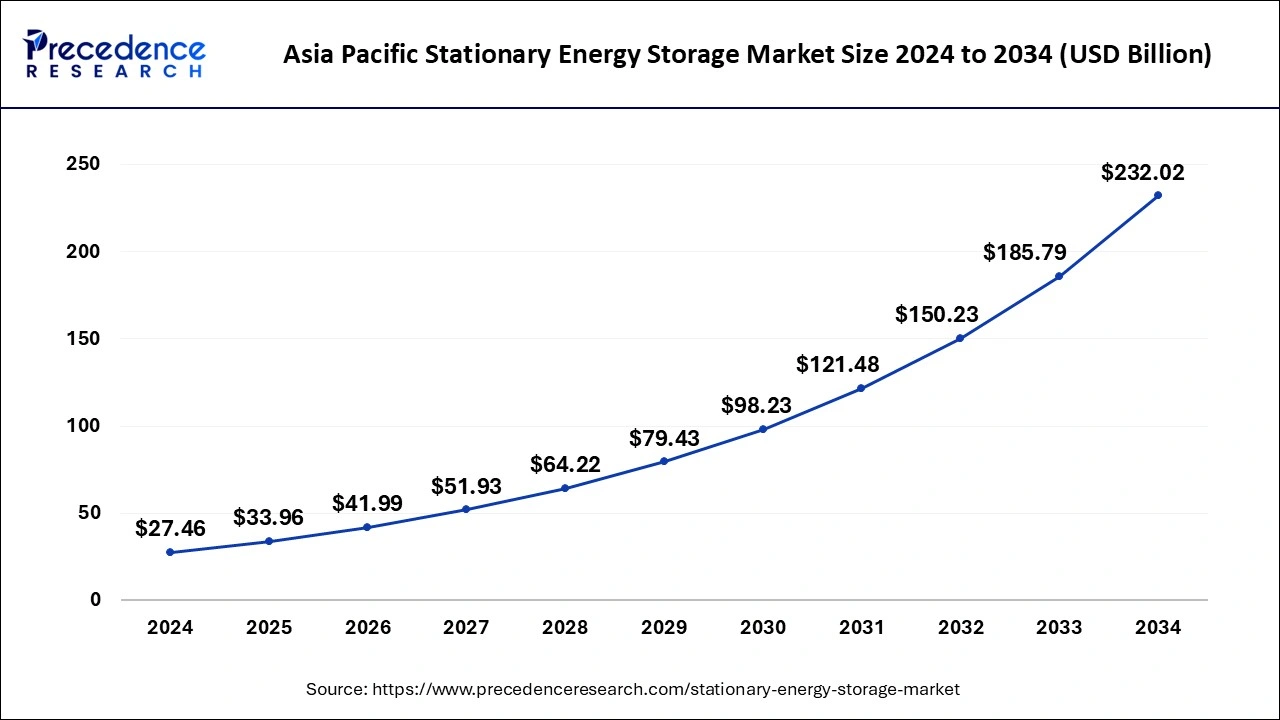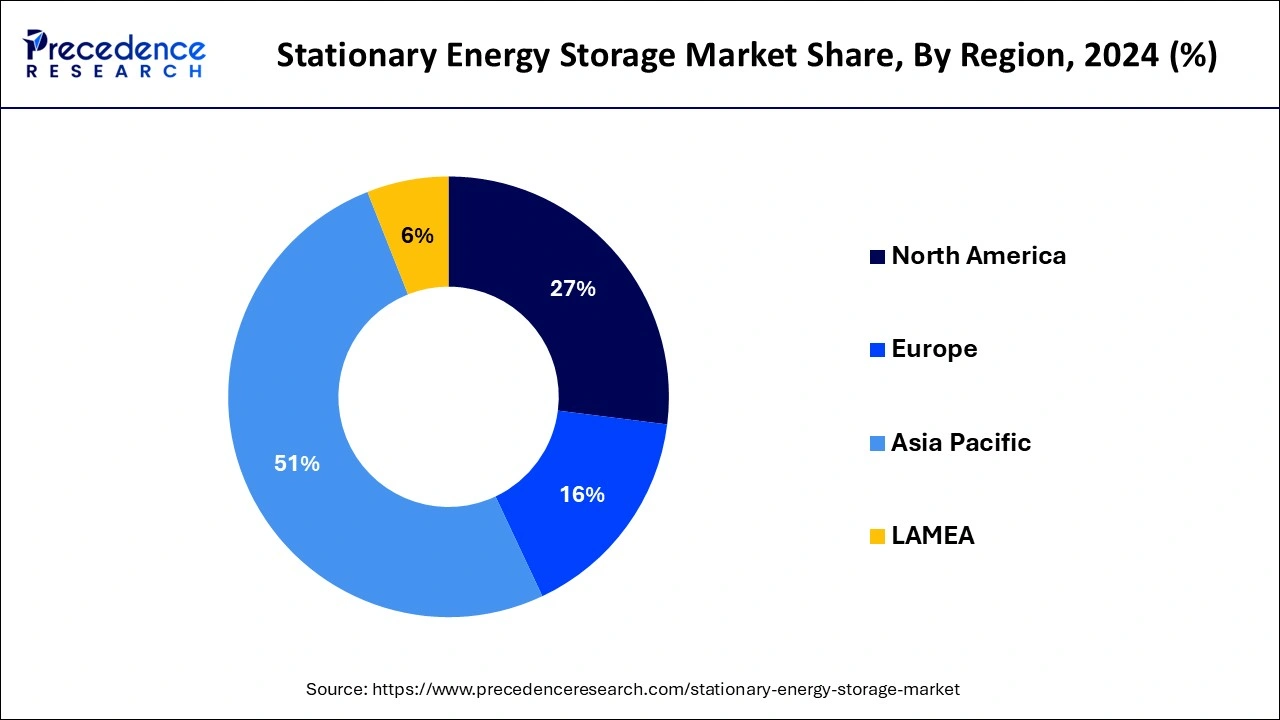February 2025
The global stationary energy storage market size is accounted at USD 66.58 billion in 2025 and is forecasted to hit around USD 450.52 billion by 2034, representing a CAGR of 23.67% from 2025 to 2034. The Asia Pacific market size was estimated at USD xx billion in 2024 and is expanding at a CAGR of xx% during the forecast period. The market sizing and forecasts are revenue-based (USD Million/Billion), with 2024 as the base year.
The global stationary energy storage market size was calculated at USD 53.84 billion in 2024 and is predicted to reach around USD 450.52 billion by 2034, expanding at a CAGR of 23.67% from 2025 to 2034. The market growth is attributed to the increasing adoption of renewable energy sources and the growing need for efficient, reliable energy storage solutions to support grid stability and energy security.

Artificial intelligence (AI) is becoming more prevalent in the stationary energy storage market as it extends operational performance, offers better maintenance practices, and optimizes energy management. Artificial intelligence uses data from energy storage devices, including batteries, to predict their performance, look for signs of failure, and manage energy distribution most efficiently. Through machine learning, energy storage systems optimize the effective utilization and integration of energy in the grid system. Furthermore, AI helps in the development of smart storage systems, enabling real-time monitoring of stored energy to avoid further damage to batteries.
The Asia Pacific stationary energy storage market size was evaluated at USD 27.46 billion in 2024 and is projected to be worth around USD 232.02 billion by 2034, growing at a CAGR of 23.79% from 2025 to 2034.

Asia Pacific dominated the stationary energy storage market in 2024. The global market for stationary energy storage has been driven by the trend of switching from conventional power generation to clean and green sources of energy.

Europe, on the other hand, is expected to develop at the fastest rate during the forecast period. Current energy efficiency reforms, along with growing worries about supply security will boost market share. The region’s harsh climatic conditions have created a beneficial setting for battery manufacturing companies.
| Report Coverage | Details |
| Market Size in 2025 | USD 66.58 Billion |
| Market Size in 2034 | USD 450.52 Billion |
| Market Growth Rate from 2025 to 2034 | CAGR of 23.67% from 2025 to 2034 |
| Largest Market | Asia Pacific |
| Fastest Growing Market | Europe |
| Base Year | 2024 |
| Forecast Period | 2025 to 2034 |
| Segments Covered | Battery, Type of Energy Storage, Application, Region |
| Regions Covered | North America, Europe, Asia-Pacific, Latin America, and Middle East & Africa |
Renewable Energy Integration
The rapid deployment of renewable energy and favorable government measures to reduce carbon emissions are the primary drivers of the stationary energy storage market. With the continued integration of clean energy systems such as wind and solar, the need for cost-effective energy storage solutions for network synchronization is rising, which is likely to drive the demand for stationary energy storage. In addition, the growing demand for renewable energy is anticipated to drive the growth of the market. Tahoe electrical storage systems are important in leveling consumption patterns and supply since they store power generated at hours of excess production and can supply during periods of shortage. According to the IEA, global renewable electricity generation is forecast to climb to over 17,000 terawatt-hours (TWh) by 2030, an increase of almost 90% from 2023. This highlights the need for storage that can handle the diversification of renewable power generation.
Technological Limitations
Technological limitations in terms of energy density and efficiency are anticipated to hamper the growth of the market. These challenges can affect the performance and reliability of stationary energy storage systems. These systems also degrade quickly, which makes them less efficient with time and need replacement more often. The current energy storage techniques are not yet optimal, and enhancing these solutions to meet global energy storage needs is challenging. Moreover, integrating energy storage systems with existing energy infrastructure is complex, restraining the growth of the market.
Rising Grid Modernization
Increasing focus on grid modernization creates immense opportunities in the market. Utility companies worldwide are spending heavily on refurbishment and expansion of their ever-demanding electric networks. With the rise of smart grids, there will be a high demand for energy storage systems. Smart grids often require energy storage systems for efficient utilization of renewable energy, power regulation, and grid functionality enhancement. Additionally, the growing focus on modernizing aging infrastructures with smart grid systems will fuel the growth of the market.
In 2024, the sodium Sulphur segment dominated the stationary energy storage market. The main factors driving product demand are high energy density, increased safety prospects, and long battery life.
The lithium-ion segment, on the other hand, is predicted to develop at the quickest rate in the future years. Lithium-ion batteries having a longer shelf life than conventional batteries, which encourages the use of these batteries.
In 2024, the hydrogen and ammonia storage segment dominated the stationary energy storage market. In contrast to mobile applications, hydrogen density is not a significant issue in stationary applications. Stationary uses such as compressed hydrogen in a hydrogen tank, liquid hydrogen in a cryogenic hydrogen tank, and slush hydrogen in a cryogenic hydrogen tank can all be used in mobile applications.
By Battery
By Type of Energy Storage
By Application
By Geography
For inquiries regarding discounts, bulk purchases, or customization requests, please contact us at sales@precedenceresearch.com
No cookie-cutter, only authentic analysis – take the 1st step to become a Precedence Research client
February 2025
January 2025
January 2025
August 2024